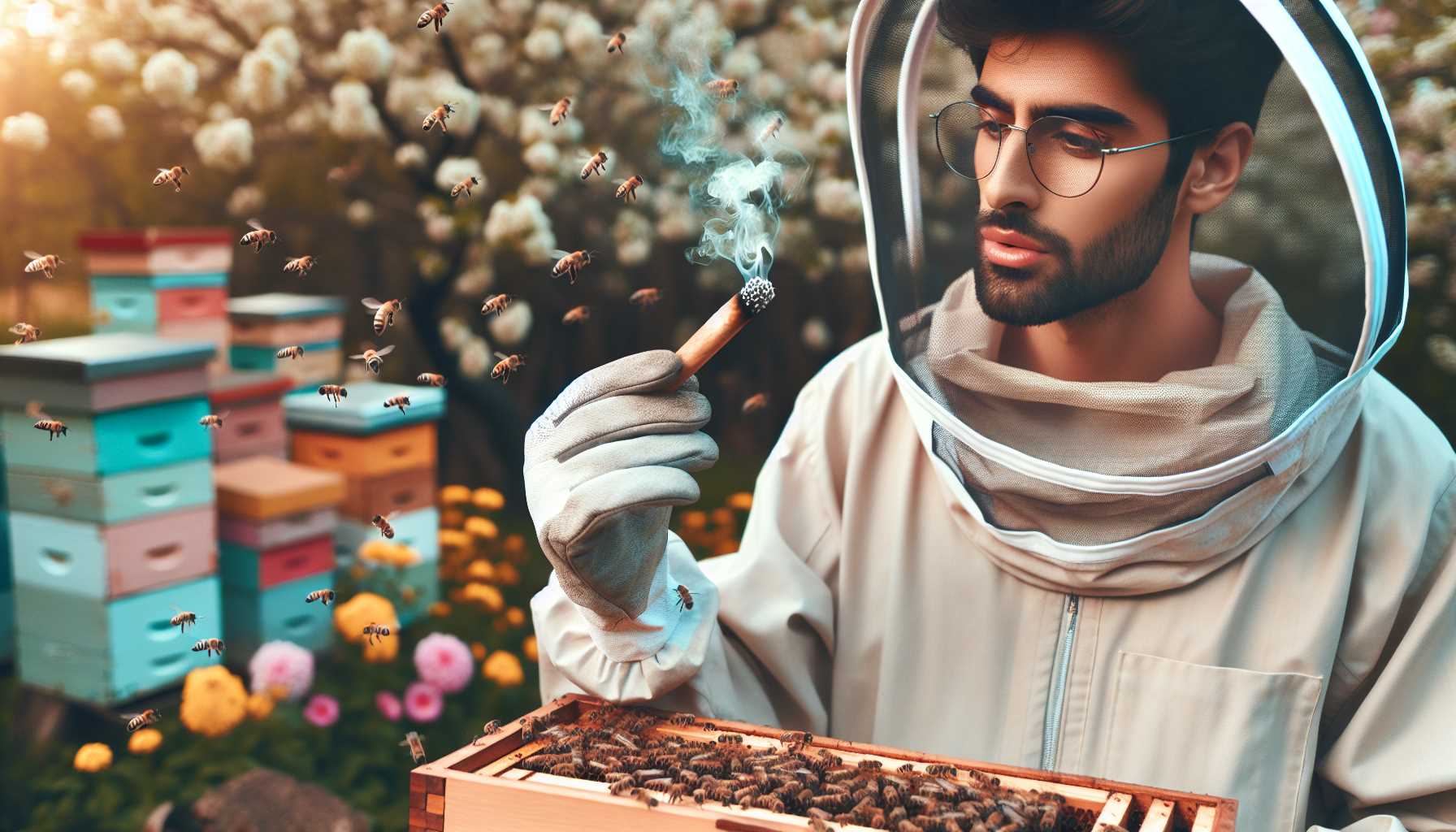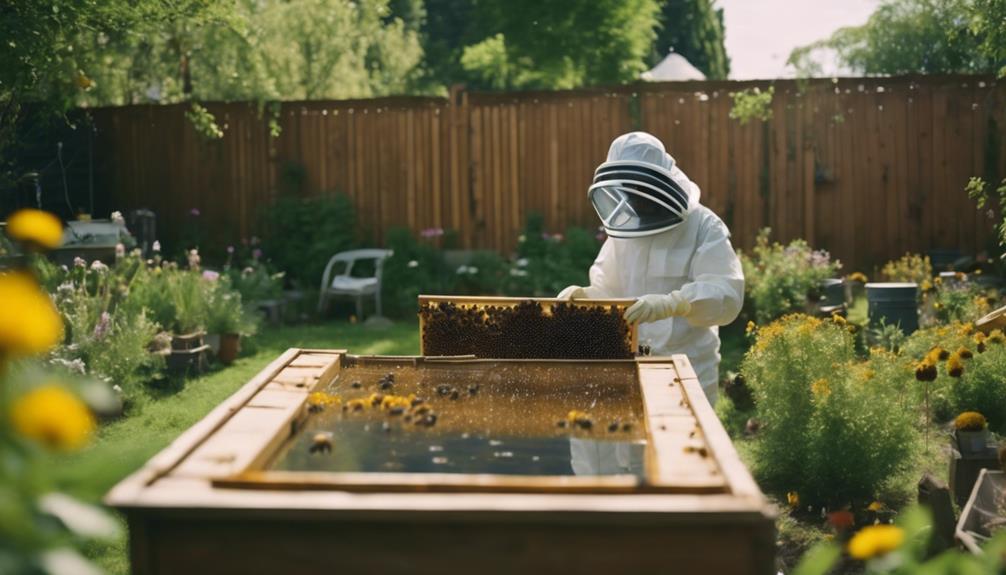Embarking on the journey of beekeeping can be both rewarding and challenging for beginners. The allure of harvesting your honey and supporting pollination in your area is undeniable. However, the complexities involved in managing a hive, understanding the intricate behaviors of bees, and ensuring their well-being can be daunting for those new to the practice.
As with any new endeavor, adequate preparation and knowledge are key. In this guide, we will explore the essential aspects of beekeeping, providing insights and tips to help you navigate this fascinating yet demanding hobby.
Key Takeaways
- Beekeeping requires understanding bee behavior and essential equipment.
- Regular hive inspections and proper management are crucial for success.
- Challenges like pests and weather can impact bee colonies.
- Beekeeping contributes to sustainability, pollination, and natural balance.
Benefits of Beekeeping
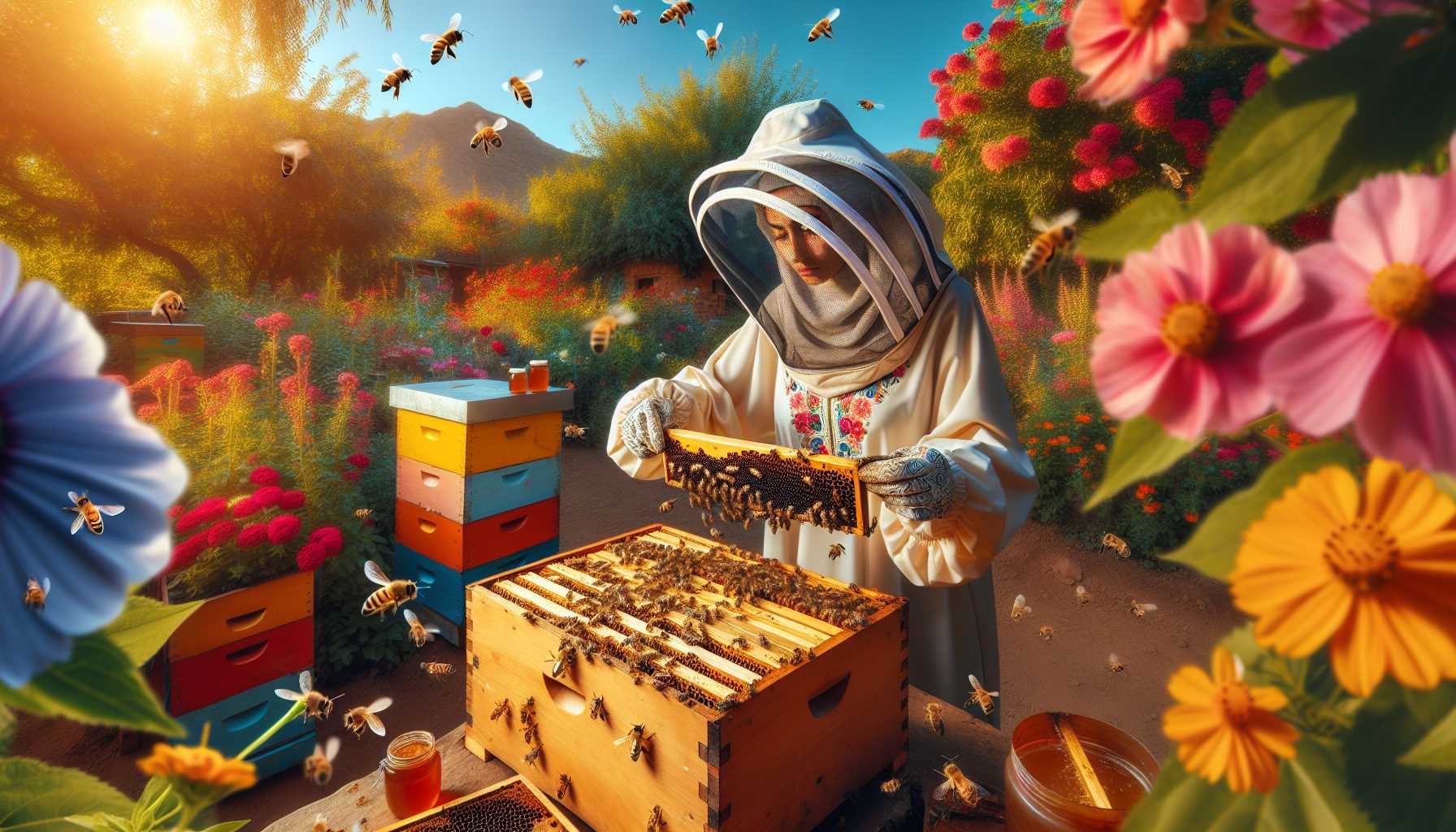
Beekeeping offers a myriad of advantages that not only benefit the environment but also provide a rewarding experience for beginners and seasoned enthusiasts alike. The health benefits of beekeeping are vast and varied. Raw honey, beeswax, propolis, and royal jelly produced by bees have been used for centuries in traditional medicine for their healing properties. Consuming raw honey can help alleviate allergies, soothe sore throats, and even boost the immune system. Additionally, bee venom therapy is gaining popularity for its anti-inflammatory effects and potential pain relief benefits.
On the environmental front, beekeeping plays a crucial role in pollination, ensuring the health and biodiversity of ecosystems. Bees are responsible for pollinating a significant portion of the world’s food crops, including fruits, vegetables, and nuts. By keeping bees, individuals contribute to the conservation of pollinators and help maintain a sustainable balance in nature. The positive impact of beekeeping on the environment is undeniable, making it a fulfilling and purposeful hobby for anyone passionate about sustainability and ecological well-being.
Essential Beekeeping Equipment

Aspiring beekeepers, equipping yourself properly is key to your success in this rewarding endeavor. Understanding the basic tools needed, the protective gear required, and the essential hive components will set you on the right path to caring for your bees effectively.
Let’s explore each of these crucial aspects in detail to ensure you are well-prepared for your beekeeping journey.
Basic Tools Needed
Equipping oneself with the essential tools for beekeeping is crucial for success in this rewarding and fascinating endeavor. To effectively manage your beehive and practice advanced beekeeping techniques, it is essential to have the following basic tools:
- Smoker: Used to calm bees during inspections.
- Hive Tool: Helps pry apart hive components and scrape off propolis.
- Bee Brush: Gently removes bees from frames without harming them.
- Feeder: Provides supplemental food to bees when nectar is scarce.
- Queen Excluder: Prevents the queen from laying eggs in honey supers.
These tools are fundamental for efficient beehive management and seasonal care, enabling beekeepers to work with confidence and ease.
Protective Gear Required
Ensuring personal safety is paramount in the world of beekeeping, necessitating the use of specific protective gear to shield oneself from potential stings and bee-related hazards. When it comes to beekeeping safety, wearing a bee suit, gloves, veil, and closed-toe shoes is non-negotiable. These items form a protective barrier between you and the bees, reducing the risk of stings during hive inspection and seasonal maintenance tasks.
Proper cleaning techniques for your protective gear are crucial to maintain their effectiveness and durability. Regularly inspecting the gear for any wear and tear is also essential for staying safe while tending to your bees. Remember, investing in high-quality protective gear is investing in your safety and enjoyment of beekeeping.
Hive Components Essential
One of the fundamental aspects of successful beekeeping is ensuring that you have all the essential hive components in place, each playing a crucial role in the maintenance and productivity of your bee colonies.
- Hive Boxes: Provide space for bees to build comb and store honey.
- Frames: Support comb building and organization within the hive.
- Bottom Board: Acts as the base of the hive, offering an entrance for bees.
- Inner Cover: Helps regulate temperature and humidity within the hive.
- Outer Cover: Protects the hive from the elements and predators.
These components are vital for effective queen management and swarm prevention, key factors in maintaining healthy and thriving bee colonies. Investing in quality hive equipment is essential for beginner beekeepers seeking success in their beekeeping journey.
Understanding Bee Behavior

Understanding bee behavior is crucial for successful beekeeping.
The hive’s social structure, including the roles of the queen, workers, and drones, plays a significant role in the overall functioning of the colony.
Additionally, communication methods such as the waggle dance are fascinating aspects of how bees interact and coordinate within the hive.
Hive Social Structure
The intricate social structure within a beehive reveals the fascinating dynamics of bee behavior. Within the hive, a complex hierarchy exists, showcasing the following key elements:
- Queen Hierarchy: The queen bee reigns supreme, responsible for laying eggs and maintaining the colony’s population.
- Worker Duties: The worker bees, predominantly female, undertake various tasks crucial for hive function, including foraging, nursing the brood, and hive maintenance.
- Division of Labor: Bees divide tasks efficiently, ensuring the smooth running of the hive.
- Communication: Bees communicate through intricate dances and pheromones, orchestrating collective decisions.
- Unity: Despite their individual roles, bees work cohesively towards the common goal of hive survival, emphasizing the strength of unity in the face of adversity.
Communication Methods
Within the intricate world of bee behavior, communication methods play a pivotal role in orchestrating the collective activities and decisions of the hive. Bees communicate through various means, such as intricate dances, pheromones, and vibrations, to convey essential information about food sources, potential threats, and swarm movements.
Understanding these communication methods is crucial for beekeepers to interpret the needs and behaviors of their hives accurately. As a beginner, delving into beekeeping classes, workshops, and joining local clubs can provide valuable insights into bee behavior and communication techniques. Additionally, engaging in online forums allows for knowledge-sharing with experienced beekeepers and fosters a supportive community where questions can be asked and guidance sought.
Setting Up Your Beehive

Setting up your beehive is an essential step in establishing a successful and thriving beekeeping operation. Proper hive placement and seasonal management are crucial for the health and productivity of your bees. Here are some key points to consider when setting up your beehive:
- Location: Choose a site that receives morning sun and afternoon shade, with a source of freshwater nearby.
- Orientation: Ensure the hive entrance faces southeast to capture the warmth of the morning sun.
- Protection: Shield the hive from strong winds using natural barriers like shrubs or fences.
- Elevation: Elevate the hive slightly to prevent water accumulation around the base.
- Accessibility: Place the hive in an area that is easily accessible for regular inspections and maintenance tasks.
Beekeeping Maintenance Tasks
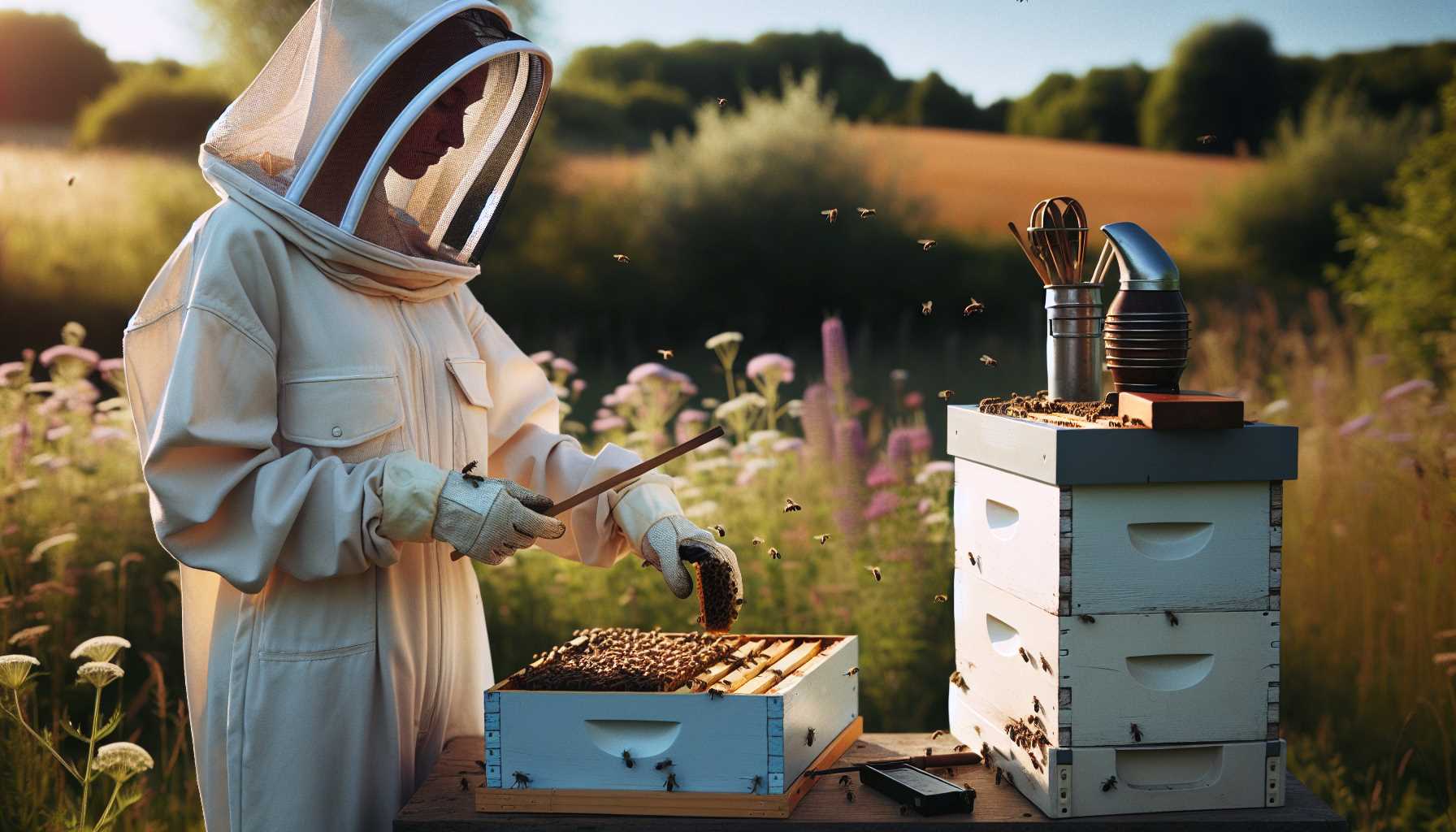
Engaging in regular beekeeping maintenance tasks is fundamental for ensuring the well-being and productivity of your bee colony. Hive inspection is a crucial aspect of beekeeping maintenance, allowing you to monitor the health of your bees, assess the strength of the colony, and ensure the queen is present and active. Regular inspections help in identifying issues early on, such as diseases, pests, or lack of food, enabling prompt intervention.
Pest management is another critical maintenance task in beekeeping. Keeping your hive protected from common threats like Varroa mites, wax moths, and hive beetles is essential for the survival of your bees. Implementing integrated pest management strategies can help minimize the use of chemicals while effectively controlling pests.
Dealing With Common Beekeeping Challenges
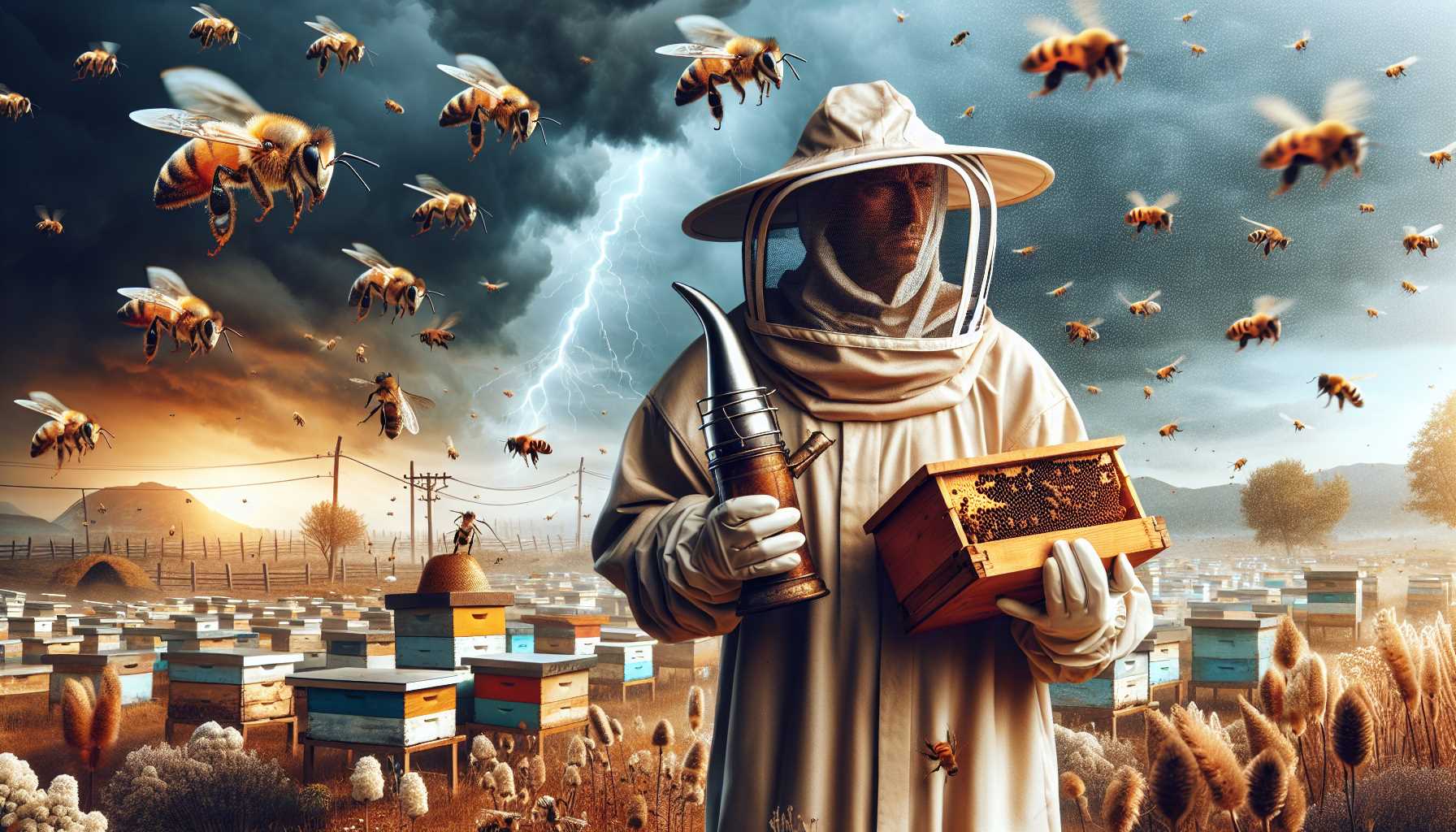
Successfully navigating the world of beekeeping requires a keen awareness of the common challenges that beekeepers often encounter. To ensure a successful beekeeping journey, it is essential to be prepared to face these challenges head-on.
- Pest Management: Dealing with pests such as varroa mites and hive beetles can be a significant challenge for beekeepers. Implementing effective pest management strategies is crucial to maintaining healthy and thriving bee colonies.
- Weather Conditions: Extreme weather conditions, such as sudden temperature drops or prolonged periods of rain, can impact bee colonies. Beekeepers need to monitor weather forecasts and take appropriate measures to protect their bees from adverse conditions.
- Hive Health: Regular hive inspections are vital to ensuring the health of bee colonies. Monitoring for signs of disease, parasites, or other issues can help beekeepers address problems promptly.
- Queen Bee Health: The queen bee plays a crucial role in the colony’s success. Beekeepers must regularly check the queen bee’s health and productivity to maintain a strong and productive hive.
- Robbing: Bee colonies are at risk of being robbed by other bees. Preventing robbing behavior and protecting the hive’s resources are essential tasks for beekeepers.
Frequently Asked Questions
Can I Start Beekeeping in a Small Backyard or Do I Need a Large Space?
Backyard beekeeping, also known as urban beekeeping, can thrive in small spaces with proper hive placement. With strategic hive management and a focus on bee health, you can start your beekeeping journey in a small backyard setting.
How Do I Know if Beekeeping Is Legal in My Area and What Permits/Licenses Do I Need?
Before starting beekeeping, research local regulations. Obtain necessary permits and licenses. Check residential restrictions and space requirements. Ensure compliance with laws. Contact local authorities for specific guidelines on beekeeping in your area.
Are There Any Specific Plant or Flower Requirements for Setting up a Bee-Friendly Environment?
Creating a pollinator-friendly landscape involves selecting a variety of bee-attracting flowers and plants. Choose native species, provide a mix of colors and shapes, and ensure continuous blooms throughout the seasons to support bee health and diversity.
What Are Some Common Mistakes Beginner Beekeepers Make and How Can I Avoid Them?
Navigating the intricate dance of hive maintenance and queen management requires finesse. Avoid common mistakes by prioritizing regular hive inspection, gentle honey extraction methods, and vigilant queen monitoring. Embrace the art of beekeeping with dedication and grace.
How Can I Ensure the Safety of My Family and Neighbors While Beekeeping?
Ensuring safety in beekeeping is paramount. Communicate with family, neighbors, and local authorities about your apiary. Educate them on safety measures, provide protective gear, and establish clear communication channels. Regular inspection and maintenance routines are essential for a safe beekeeping environment.

Hello! My name is Noel Calvin. I graduated from UCLA and now work as a writer at Launch Ninjas. I write blog posts that inspire and guide our readers in their entrepreneurial pursuits. I live in Pleasantville, NJ, with a peaceful yet lively atmosphere that inspires me.
Writing stories is more than just a job for me. It allows me to share my observations and satisfy my curiosity about the world. I combine my analytical skills with creative enthusiasm to delve into technology trends and startup stories. But my life isn’t limited to screens and keyboards. I value loyalty, passion, and a touch of old-fashioned charm, which I infuse into every narrative I create.
I love spending time in my garage, jamming with my band when I’m not writing. Playing the guitar and singing bring me immense joy. I also enjoy capturing ordinary and extraordinary moments through my camera lens and exploring new culinary adventures that excite my taste buds. I’m always seeking new experiences.
My family is very important to me. Joyful Sunday brunches filled with laughter and intense board game nights keep me grounded, reminding me of life’s simple pleasures.
In my world, every moment is an opportunity for discovery. Every discovery is a story worth sharing, whether a heartfelt moment at home or the pulse of technological innovations. Join me as I navigate through life, one blog post, one guitar strum, and one heartwarming family dinner at a time.
